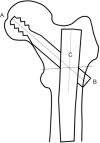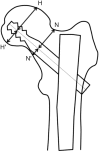Comparison of the Sliding and Femoral Head Rotation among Three Different Femoral Head Fixation Devices for Trochanteric Fractures
- PMID: 26330949
- PMCID: PMC4553275
- DOI: 10.4055/cios.2015.7.3.291
Comparison of the Sliding and Femoral Head Rotation among Three Different Femoral Head Fixation Devices for Trochanteric Fractures
Abstract
Background: Recently, various femoral head fixation devices (HFDs) for trochanteric fractures have become available. However, there are some cases in which femoral head rotation with excessive sliding of the HFD is observed and it is often followed by cutout. The purpose of this study is to compare the ability of the three types of HFDs to prevent femoral head rotation.
Methods: Between July 2005 and December 2009, 206 patients aged over 60 years with trochanteric fractures who had undergone surgical treatment using a short femoral nail in our institution were enrolled into the study. We used the gamma 3 nail (GMN) as the screw-type HFD in 66 cases, the gliding nail (GLN) as a non-cylindrical blade in 76 cases, and the proximal femoral nail antirotation (PFNA) as a cylindrical blade in 64 cases. The sliding length of HFDs and the occurrence of femoral head rotation were evaluated by assessing radiographs as the main outcome, and the results were compared among these devices.
Results: A comparison of the degree of sliding in the GMN group showed that femoral head rotation was observed significantly more frequently in cases with rotation. Further, it appeared that femoral head rotation occurred more frequently in comminuted fractures. However, no significant differences between the sliding lengths of the different HFDs were observed among three groups. Femoral head rotation was observed in 15 cases of GMN (22.7%), 0 case of GLN, and 5 case of PFNA (7.8%). Significant differences with regard to the occurrence of femoral head rotation were observed among the three groups. Furthermore, significant differences were also observed between GLN and PFNA with respect to the occurrence of femoral head rotation.
Conclusions: The ability to stabilize femoral head appears to be greater with blade-type materials than with screw-type materials. Furthermore, we believe that a non-cylindrical blade is preferable to a cylindrical blade for the surgical treatment of comminuted, unstable trochanteric fractures in order to prevent femoral head rotation and cut-out.
Keywords: Femur head; Hip fractures; Orthopedic fixation devices; Postoperative complication.
Conflict of interest statement
Figures




Similar articles
-
Radiographic and functional results of osteosynthesis using the proximal femoral nail antirotation (PFNA) in the treatment of unstable intertrochanteric femoral fractures.Acta Orthop Traumatol Turc. 2010;44(2):127-34. doi: 10.3944/AOTT.2010.2237. Acta Orthop Traumatol Turc. 2010. PMID: 20676015
-
Acetabular perforation after medial migration of the helical blade through the femoral head after treatment of an unstable trochanteric fracture with proximal femoral nail antirotation (PFNA): a case report.J Orthop Trauma. 2011 Sep;25(9):e86-9. doi: 10.1097/BOT.0b013e3181fae12e. J Orthop Trauma. 2011. PMID: 21577153
-
The new proximal femoral nail antirotation (PFNA) in daily practice: results of a multicentre clinical study.Injury. 2008 Aug;39(8):932-9. doi: 10.1016/j.injury.2008.02.005. Epub 2008 Jun 25. Injury. 2008. PMID: 18582887
-
[Trochanteric femoral fractures].Acta Chir Orthop Traumatol Cech. 2013;80(1):15-26. Acta Chir Orthop Traumatol Cech. 2013. PMID: 23452417 Review. Czech.
-
Alternative techniques in trochanteric hip fracture surgery. Clinical and biomechanical studies on the Medoff sliding plate and the Twin hook.Acta Orthop Scand Suppl. 2000 Oct;295:1-31. Acta Orthop Scand Suppl. 2000. PMID: 11116961 Review.
Cited by
-
Primary hemiarthroplasty for treatment of unstable pertrochanteric femoral fractures (AO/OTA Type 31 A2.3) in elderly osteoporotic patients.SICOT J. 2017;3:31. doi: 10.1051/sicotj/2017013. Epub 2017 Apr 7. SICOT J. 2017. PMID: 28387197 Free PMC article.
-
Migration of the Lag Screw after Intramedullary Treatment of AO/OTA 31.A2.1-3 Pertrochanteric Fractures Does Not Result in Higher Incidence of Cut-Outs, Regardless of Which Implant Was Used: A Comparison of Gamma Nail with and without U-Blade (RC) Lag Screw and Proximal Femur Nail Antirotation (PFNA).J Clin Med. 2019 May 7;8(5):615. doi: 10.3390/jcm8050615. J Clin Med. 2019. PMID: 31067639 Free PMC article.
-
A comparison of two fixation methods for femoral trochanteric fractures: a new generation intramedullary system vs sliding hip screw.Clin Cases Miner Bone Metab. 2017 Jan-Apr;14(1):40-47. doi: 10.11138/ccmbm/2017.14.1.040. Epub 2017 May 30. Clin Cases Miner Bone Metab. 2017. PMID: 28740524 Free PMC article.
-
Usefulness of Synthetic Osteoconductive Bone Graft Substitute with Zeta Potential Control for Intramedullary Fixation with Proximal Femur Nail Antirotation in Osteoporotic Unstable Femoral Intertrochanteric Fracture.Hip Pelvis. 2021 Dec;33(4):211-218. doi: 10.5371/hp.2021.33.4.211. Epub 2021 Dec 1. Hip Pelvis. 2021. PMID: 34938690 Free PMC article.
-
Clinical Outcomes of U-blade Gamma3 Nails Used to Treat Patients with Trochanteric Fractures: Retrospective Multicenter Study.Hip Pelvis. 2019 Jun;31(2):95-101. doi: 10.5371/hp.2019.31.2.95. Epub 2019 May 30. Hip Pelvis. 2019. PMID: 31198776 Free PMC article.
References
-
- Kannus P, Parkkari J, Sievanen H, Heinonen A, Vuori I, Jarvinen M. Epidemiology of hip fractures. Bone. 1996;18(1 Suppl):57S–63S. - PubMed
-
- Xu YZ, Geng DC, Mao HQ, Zhu XS, Yang HL. A comparison of the proximal femoral nail antirotation device and dynamic hip screw in the treatment of unstable pertrochanteric fracture. J Int Med Res. 2010;38(4):1266–1275. - PubMed
-
- Fritz T, Weiss C, Krieglstein C, Quentmeier A. The classic nail in the therapy of trochanteric fractures: a prospective, controlled study. Arch Orthop Trauma Surg. 1999;119(5-6):308–314. - PubMed
-
- Curtis MJ, Jinnah RH, Wilson V, Cunningham BW. Proximal femoral fractures: a biomechanical study to compare intramedullary and extramedullary fixation. Injury. 1994;25(2):99–104. - PubMed
-
- Radford PJ, Needoff M, Webb JK. A prospective randomised comparison of the dynamic hip screw and the gamma locking nail. J Bone Joint Surg Br. 1993;75(5):789–793. - PubMed
Publication types
MeSH terms
LinkOut - more resources
Full Text Sources
Other Literature Sources
Medical

